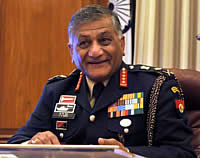Indian Army Chief: Nukes Not For Warfighting
 |
| Gen. V.K. Singh |
.
By Hans M. Kristensen
India’s nuclear weapons “are not for warfighting,” the chief of India’s army said Sunday at the Army Day Parade. The weapons have “a strategic capability and that is where it should end,” General V. K. Singh declared.
The rejection of nuclear warfighting ideas is a welcoming development in the debate over the role of nuclear weapons in South Asia. Pakistan’s military’s description of its new snort-range NASR missile as a “shoot and scoot…quick response system” has rightly raised concerns about the potential early use of nuclear weapons in a conflict.
NASR is one of several new nuclear weapon systems that are nearing deployment with warheads from a Pakistani stockpile that has nearly doubled since 2005.
India is also increasing its arsenal and already has short-range missiles with nuclear capability: the land-based Prithvi has been in operation for a decade, and a naval version (Dhanush) is under development. But India’s posture seems focused on getting its medium-range Agni II in operation, developing longer-range versions to target China, and building a limited submarine-based nuclear capability.
If Gen. Singh’s rejection of nuclear warfighting is reflected in India’s future nuclear posture, two important things will have been achieved: rejection of the mindless tit-for-tat philosophy that otherwise dominates nuclear posturing; and limiting the scenarios where nuclear weapons otherwise could come into use. The rejection also has importance for other nuclear weapon states, where some have called for making nuclear weapons more “tailored” to limited regional scenarios.
This publication was made possible by a grant from Carnegie Corporation of New York and Ploughshares Fund. The statements made and views expressed are solely the responsibility of the author.
Satellite imagery of RAF Lakenheath reveals new construction of a security perimeter around ten protective aircraft shelters in the designated nuclear area, the latest measure in a series of upgrades as the base prepares for the ability to store U.S. nuclear weapons.
It will take consistent leadership and action to navigate the complex dangers in the region and to avoid what many analysts considered to be an increasingly possible outcome, a nuclear conflict in East Asia.
How the United States responds to China’s nuclear buildup will shape the global nuclear balance for the rest of the century.
The bootcamp brought more than two dozen next-generation open-source practitioners from across the United States to Washington DC, where they participated in interactive modules, group discussions, and hands-on sleuthing.